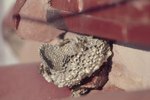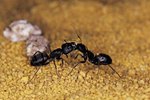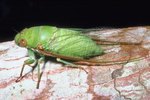
Castes are divisions within an insect species. Members of castes have marked physiological differences from those of other castes within the species. Termites have castes, the members of which are specially adapted to perform their specific function within the colony. Because they are considered pest insects, termites don't get much credit from humans for their remarkable social structure. The fact is, termites' segregated castes help keep the colony running efficiently.
The King and Queen
Alates, or reproductive termites, leave a nest at maturity to go on mating flights, when they mate with termites from other colonies. Alates have tougher skin than subterranean termites, so they can withstand the harsh conditions outside the nest. They're the only termites with eyes. A pair of mating alates establish their own colony. The queen is responsible for laying all the eggs for her colony. Her head and thorax resemble a normal termite, but her abdomen is hugely distended, bulbous, long and white. She needs this specially adapted abdomen to produce up to 2,000 eggs daily. A royal couple can live up to 50 years.
Secondary Reproductives
Within the nest, backup breeders are on standby in case anything happens to the king or queen. Termites in this caste are similar to alates, because they can reproduce, but they do not have wings or eyes and never leave the nest. They are also not able to reproduce to the prolific extent that the true king and queen can. It takes several secondary reproductives to equal the king and queen's egg production levels. The female secondary reproductives have much smaller abdomens than the true queen has.
Workers
Workers perform almost all the necessary tasks needed to keep a colony running smoothly except reproduce and defend the homestead against attackers. They gather food, feed colony members in other castes, tend the eggs and young, build and repair the nest, and dispose of deceased colony members, either through burial or cannibalization. Because they don't venture outside the colony, workers have soft bodies and no eyes. Workers are basically juveniles in arrested states of development. They do have the ability to develop into soldiers or reproductives if the colony is in distress and requires more termites in these castes. They live for one to two years.
Soldiers
Soldiers are much less common in a termite colony than workers. Their primary purpose is to guard the nest; they are capable of doing little else. They are more like sentries than soldiers -- they're posted at entryways and exits to ensure no intruders make it inside. They live up to two years. Their overdeveloped mandibles, used for defending against trespassers, are useless when it comes to eating. Soldiers cannot feed themselves; worker termites feed them. Another of the soldier's defense mechanism is a sticky white substance excreted from the fontanelle -- a pore on the its head -- which gums up intruders and prevents their entry into the nest.
References
Resources
Photo Credits
-
Jupiterimages/Photos.com/Getty Images
Writer Bio
Madeline Masters works as a dog walker and professional writer. In the past she has worked as a fitness columnist, fundraising copywriter and news reporter. Masters won two Pennsylvania Newspaper Association Awards in 2009. She graduated from Elizabethtown College with a Bachelor of Arts in English.




